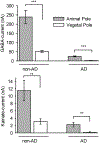Microtransplantation of Synaptic Membranes to Reactivate Human Synaptic Receptors for Functional Studies
- PMID: 35938847
- PMCID: PMC10729793
- DOI: 10.3791/64024
Microtransplantation of Synaptic Membranes to Reactivate Human Synaptic Receptors for Functional Studies
Abstract
Excitatory and inhibitory ionotropic receptors are the major gates of ion fluxes that determine the activity of synapses during physiological neuronal communication. Therefore, alterations in their abundance, function, and relationships with other synaptic elements have been observed as a major correlate of alterations in brain function and cognitive impairment in neurodegenerative diseases and mental disorders. Understanding how the function of excitatory and inhibitory synaptic receptors is altered by disease is of critical importance for the development of effective therapies. To gain disease-relevant information, it is important to record the electrical activity of neurotransmitter receptors that remain functional in the diseased human brain. So far this is the closest approach to assess pathological alterations in receptors' function. In this work, a methodology is presented to perform microtransplantation of synaptic membranes, which consists of reactivating synaptic membranes from snap frozen human brain tissue containing human receptors, by its injection and posterior fusion into the membrane of Xenopus laevis oocytes. The protocol also provides the methodological strategy to obtain consistent and reliable responses of α-amino-3-hydroxy-5-methyl-4-isoxazolepropionic acid (AMPA) and γ-aminobutyric acid (GABA) receptors, as well as novel detailed methods that are used for normalization and rigorous data analysis.
Conflict of interest statement
Disclosures
The authors have no conflicts of interest to disclose.
Figures



Similar articles
-
Microtransplantation of cellular membranes from squid stellate ganglion reveals ionotropic GABA receptors.Biol Bull. 2013 Feb;224(1):47-52. doi: 10.1086/BBLv224n1p47. Biol Bull. 2013. PMID: 23493508
-
Reconstitution of synaptic Ion channels from rodent and human brain in Xenopus oocytes: a biochemical and electrophysiological characterization.J Neurochem. 2016 Aug;138(3):384-96. doi: 10.1111/jnc.13675. Epub 2016 Jun 13. J Neurochem. 2016. PMID: 27216696 Free PMC article.
-
Expression of functional neurotransmitter receptors in Xenopus oocytes after injection of human brain membranes.Proc Natl Acad Sci U S A. 2002 Oct 1;99(20):13238-42. doi: 10.1073/pnas.192445299. Epub 2002 Sep 17. Proc Natl Acad Sci U S A. 2002. PMID: 12237406 Free PMC article.
-
Microtransplantation of neurotransmitter receptors from cells to Xenopus oocyte membranes: new procedure for ion channel studies.Methods Mol Biol. 2006;322:347-55. doi: 10.1007/978-1-59745-000-3_24. Methods Mol Biol. 2006. PMID: 16739735 Review.
-
AMPA receptors in the synapse: Very little space and even less time.Neuropharmacology. 2021 Sep 15;196:108711. doi: 10.1016/j.neuropharm.2021.108711. Epub 2021 Jul 13. Neuropharmacology. 2021. PMID: 34271021 Review.
Cited by
-
Microtransplantation of Postmortem Native Synaptic mGluRs Receptors into Xenopus Oocytes for Their Functional Analysis.Membranes (Basel). 2022 Sep 26;12(10):931. doi: 10.3390/membranes12100931. Membranes (Basel). 2022. PMID: 36295690 Free PMC article.
References
Publication types
MeSH terms
Substances
Grants and funding
LinkOut - more resources
Full Text Sources
